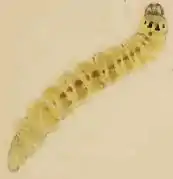| Parornix scoticella | |
|---|---|
 | |
| Scientific classification | |
| Domain: | Eukaryota |
| Kingdom: | Animalia |
| Phylum: | Arthropoda |
| Class: | Insecta |
| Order: | Lepidoptera |
| Family: | Gracillariidae |
| Genus: | Parornix |
| Species: | P. scoticella |
| Binomial name | |
| Parornix scoticella | |
| Synonyms | |
| |
Parornix scoticella is a moth of the family Gracillariidae. It is known from all of Europe.


The wingspan is about 10 mm. The head is whitish, mixed with fuscous. Palpi white. Forewings are dark fuscous, towards base irrorated with white: numerous costal strigulae, a spot in disc posteriorly, and two dorsal spots preceded by blackish spots white; a black apical spot, anteriorly white-margined; cilia with three entire dark fuscous lines. Hindwings are grey. The larva is pale yellow-green; dorsal line dark green or red-brown; head pale brown; segment 2 with four black spots.[2]
Adults are on wing in May and again in August in two generations in southern parts of the range and in one generation with adults in August in the north.[3]
The larvae feed on Cotoneaster nebrodensis, Malus sylvestris, Sorbus aria, Sorbus aucuparia, Sorbus chamaemespilus, Sorbus intermedia and Sorbus torminalis. They mine the leaves of their host plant. The mine starts with a lower-surface epidermal corridor, but soon the larva starts feeding on the sponge parenchyma. The mine then becomes a flat lower-surface blotch. After leaving the mine, the larva lives freely under a folded leaf margin or in a fold at the underside of the leaf, in its centre, that is covered with silk.[4]
References
- ↑ Fauna Europaea
- ↑ Meyrick, E., 1895 A Handbook of British Lepidoptera MacMillan, London pdf
 This article incorporates text from this source, which is in the public domain. Keys and description
This article incorporates text from this source, which is in the public domain. Keys and description - ↑ UKmoths
- ↑ "bladmineerders.nl". Archived from the original on 2012-04-19. Retrieved 2010-11-03.